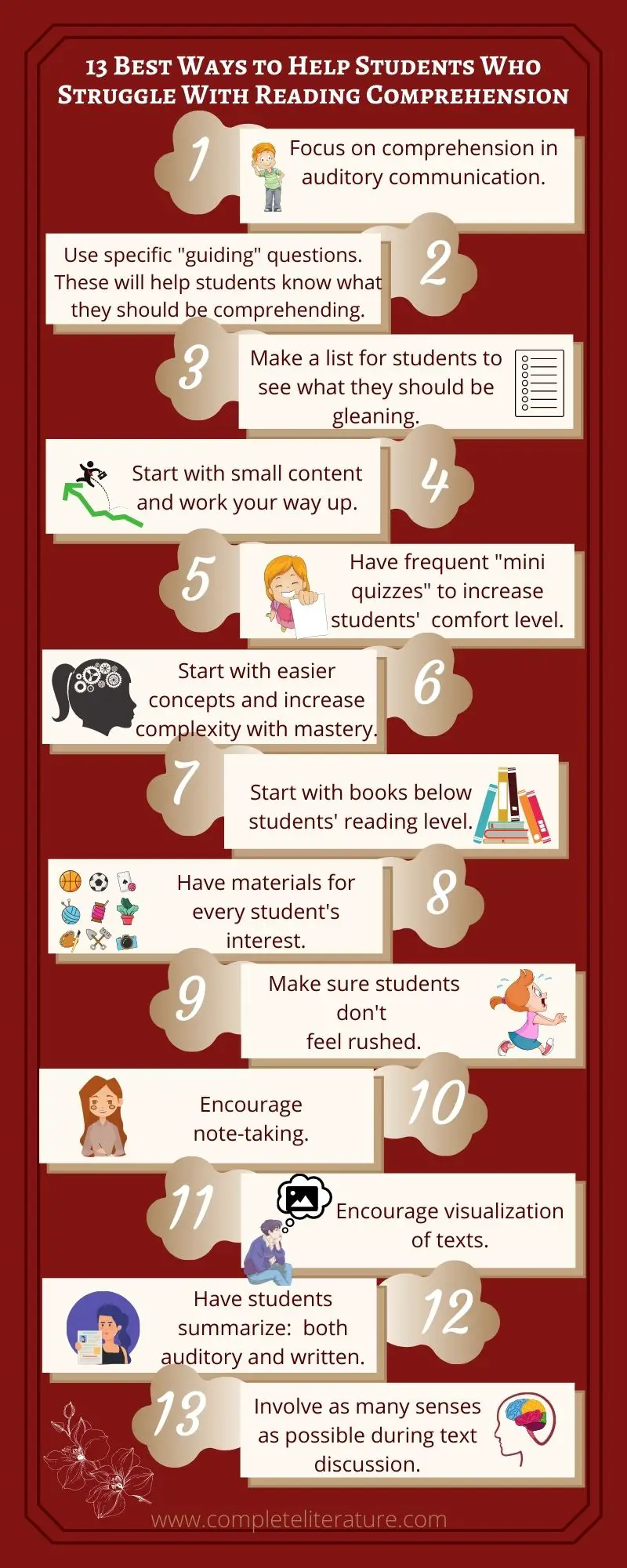Reading comprehension is a critical skill in all of life–whether in school, at work, in the community, and even in the home. It is critical to our ability to communicate effectively with others. Sometimes students know all of the rules of reading fluently, but they are not able to effectively comprehend what they are reading. Because they are able to read the words with ease, teachers and parents may sometimes miss that their student is not really comprehending what he or she is reading.
So, what are some of the best ways to help students who struggle with reading comprehension? The first and biggest step towards improving reading comprehension is to take the focus off of reading and put it on comprehending words that are spoken to them. Working one-on-one with struggling students and honing in on the items you want them to specifically comprehend will allow them to start seeing patterns of what they should be picking up in conversation. Once students show signs of improvement in comprehension through conversation, finding those same patterns in what they are reading will come more naturally, especially with the right exercises to build their comprehension skills. I spent some time researching this and found 14 of the best exercises to help students who struggle with reading comprehension build great skill and strength by the end of the school year. Here is the short list, then I will go into greater detail afterward:
1. Focus on comprehension in auditory communication.
2. Use specific “guiding questions” to help students know what they should be comprehending.
3. Make a list for students to see what they should be gleaning.
4. Start small and work your way up on the amount of content.
5. Have frequent “mini quizzes” so students will become comfortable with how they process the info they are reading.
6. Start with easier concepts and once students master those, get more complex.
7. Start with books below students’ reading level.
8. Have a selection of materials that cater to every interest.
9. Make sure students don’t feel rushed when reading.
10. Encourage note taking.
11. Encourage visualization of texts.
12. Have students summarize–both auditory and written.
13. Involve as many senses as possible during text discussion.
Table of Contents
1. Focus on Comprehension in Auditory Communication
Many times the student’s reading comprehension issues are not rooted in the reading aspect. Sometimes a student can read very fluently, but the comprehension issue is more in the understanding of the words and how the brain is picking up what the student is reading.
When this is the case, it is beneficial to work on building auditory comprehension skills.
A great way to do this is to read or speak a sentence aloud to the student and then ask them a question or two regarding details you mentioned in the sentence. As the student masters the sentences you are giving him/her, start doing 2 or 3 sentences, and once the student has mastered that, work on larger paragraphs and then full passages.
This process sounds highly involved, but more often than not, with some personal on-on-one discussion time, students progress rapidly through this process.

2. Use specific “guiding questions” to help students know what they should be comprehending.
If students have an idea of what they are looking for, they will be able to process the information they are reading much more efficiently.
For instance, telling the student(s) to look for the name of the city that the main character is visiting will help them to know exactly what they are looking for. They won’t necessarily be trying to remember every detail of every word they read. This can be a great advantage because it allows the students to hone in on certain things and not have to worry about too many things at once.
Once students are able to master pulling out a specific piece of information from the text they are reading, you can then add one or two more things for them to look for. Over time they will build the ability to pick up many facts without having to prepare ahead of time with guiding questions.
Interestingly, a prominent test-taking tip that many educational organizations recommend for doing better on regular as well as standardized tests is for the student to know what they are looking for before reading the passage so they will save time by finding facts as they are reading rather than waiting until they are finished reading. This is a great way to introduce and reinforce this technique.
As students improve with this method, it will be easier to give them the guiding questions in list form. And that brings us to our next point!
3. Make a list for students to see what they should be gleaning.
As students improve at finding the information they need to in the passages they are reading, it will be helpful to give them a list of what they need to be looking for in order to comprehend exactly what you are trying to communicate to them.
This can be given in the form of a checklist so they can systematically work through it or work through it in their own preferred style but still be able to make sure they got everything they needed to.
You can also create it with a space for notes so students can use it as a companion along with their reading. This could take them longer to read the passage, but it would be helpful for them to cement what they are reading in their minds. This makes a great foundation for students who are still learning or struggling with comprehension skills. Over time, they will no longer need to work with a list as their minds adjust to gleaning information that they read.
4. Start small and work your way up on the amount of content.
You can start with basic sentences for those that are beginning readers, have learning disabilities, or struggle greatly with reading comprehension. Of course, more advanced students can handle more than that as they begin.
Once you have worked with your student’s reading skills, you will be able to gauge how much they can easily handle pretty quickly. Make sure you start just slightly lower than their comfortable reading level (more on that in point 7) so they can concentrate more on the comprehension without the distractions of trying to work through other concepts initially.
As students master the content and move up to larger forms on content, they will be pleased with being able to see their progress and excited to keep moving along. By the end of the year, seeing the progress can be amazing!
5. Have frequent “mini quizzes” so students will become comfortable with how they process the info they are reading.
Maybe once a week, instead of giving students an outline or checklist of things to keep in mind while reading, teachers can evaluate their level of improvement in reading comprehension just by giving them material to read and then quizzing them on what they just read.
This can be done as a verbal dialog after reading or as a couple of questions on paper that they will have to write answers to. It could even be in the form of written questions that students can answer orally.
Teachers can do this as part of reading circles, stations, as a class, or even individually for those students that need a bit of extra on-on-one time.

6. Start with easier concepts and once students master those, get more complex.
As the year starts out, and with the students that struggle more with reading comprehension (or are early readers), teachers will want to start with easier concepts for the students. Start with obvious facts that students will easily remember. Then you can work up to trickier facts that are specifically stated. Before long, teachers will be able to ask questions about what students can deduce from the passage that isn’t explicitly written in the text.
Make sure to affirm students’ abilities as they grow in their comprehension skills. The more they can clearly see their progress, the bolder they will get and faster they will improve.
7. Start with books below students’ reading level.
I alluded a bit to this in point 4, when I was talking about starting students out at a lower level than they are used to.
When teachers start developing students’ comprehension skills with books that are below the students’ reading level, it allows students to concentrate on what they are reading and not on words or concepts they are unfamiliar with or are too difficult for them to read easily.
With the distractions out of the way, students are able to concentrate on the details they are reading. And teachers are able to see exactly what the level of comprehension is and where to focus to improve students’ skills in the areas they need to develop more.
Here are some great books that have an awesome selection of passages for teachers to easily find content to use with their students without having to come up with the material themselves. Teachers can start a grade level or two below where students are at and work their way up as students are ready to move on.
8. Have a selection of materials that cater to every interest.
Let’s admit it: we all comprehend way more material when we are interested in what we are reading. The same is even more true for kids. If they aren’t interested in what they’re reading, they’re checking out until the see something that is going to pique their interest.
On the flip side, when you have material that appeals to each of your students, you will have their full attention. And they will have fewer difficulties in comprehending what they are reading. Your battle is already halfway won!
Fortunately, students in elementary and middle school have a lot of the same interests, so having a selection of books that appeal to all of your students will not be very difficult. And adding to your collection year over year makes it even easier. Before you know it, you will have a very wide selection of books.
Make sure to have selections in all the different genres: biography, mystery, history, fiction, non-fiction, science fiction, fantasy, classic literature, books that have movies, and many others that I can’t even name in this one article.
9. Make sure students don’t feel rushed when reading.
Time (or more specifically, lack of time) is probably one of the biggest struggles teachers face. I constantly needed to fight the urge to be rushing my students along to get them to the next activity and keep them focused so we could get everything done. And looking back, I missed a lot of good opportunities because I always felt like I was fighting the clock.
What I learned over time was that taking the time to do things in a more deliberate and thoughtful (and less rushed) manner actually had way more value than cramming more rushed activities into the day. I know, that is pretty obvious. But sometimes as teachers, when we are in the moment, it is hard to see what we are really doing. We think we are just doing all the stuff and don’t realize that we are actually not taking the time to let the learning process work it’s magic.
Allowing the students time to absorb what they are reading is one of those difficult spots. We want them to hurry up and read so we can get on to the next thing. But that doesn’t give them the time they need to process the information they are taking in.
Just taking a breath and letting the students go at their own pace will make a striking difference in how they learn and comprehend what they are reading. The payback in education over time is way more than any time you may lose in letting them take the time they need now.
And an even bigger benefit: students who don’t feel rushed will enjoy the process even more and be excited when they see how well they are progressing. This will motivate them to keep up the process!
10. Encourage note taking.
This point ties very well into the previous point about making sure students don’t feel rushed. The note-taking process is going to eat at more valuable time in the school day. But it is so incredibly worth it.
When students take notes, they are using multiple senses to reinforce what they are reading. They will have a picture in their head of what they are writing down. They will be repeating the information as they are writing. The will be seeing what they are writing on the paper and be visually reminded of the material. And if they are speaking the words (even in their head) they are using auditory senses to reinforce the material even further.
That is a lot of senses and a lot of visuals to back up what they are learning. And that is incredibly good for helping students that struggle with comprehension to make great progress.
11. Encourage visualization of texts.
Once again, this point is a great progression from the previous point about note taking and how it helps to visualize what the students are reading about and learning.
The more different ways students can visualize the text they are reading, further comprehension of the passage can only increase. The vast majority of students in elementary and middle school are visual learners, so this is a great way to help not just students that struggle with reading comprehension, but the rest of the students as well.
There are several visualization techniques that you can use throughout the year to keep the process fresh and interesting for the students. Here is one example in this video:
12. Have students summarize–both auditory and written.
Having students summarize the passage they are reading is one of the best ways to reinforce what students are attempting to comprehend. Summarizing in both auditory and written form is icing on the cake because the two different methods cater to the strengths of the vast majority of the students. And for many students, the double reinforcement on top of the reading itself will lend itself to triple reinforcement.
You can either pair students off or have them work in small groups. Four is a perfect number because then the small groups can pair off as well. This is the best way to summarize auditorily. There really is not any need to group students for written summaries. They can all do it at the same time. Students can’t necessarily grade the work either, so the teacher will have to collect the papers and grade them later. The good news is that summaries are supposed to be short. That means you won’t be grading these papers all night!
13. Involve as many senses as possible during text discussion.
My final point in how to help students who struggle with reading comprehension is that involving as many of the senses as possible only serves to cement whatever the student has read in the sentence(s) or passages.
Using sight and sound are pretty much standards in this area. But adding taste, touch, and smell can make something ordinary and routine into an amazing object lesson.
Of course, you can’t bring food, things that smell (good or bad) or even necessarily tactile objects with you every day for every passage. That ability would be awesome, but it’s not practical. But it can be sprinkled throughout the program, and used strategically for the things you would like to drive home the most. It is a guarantee that the things that get students’ sense of smell, touch, and taste involved will be the things they remember the most!
Conclusion
This list of 13 ways to help students who struggle with reading comprehension is certainly not an exhaustive list, but it will get teachers a long way in their classroom.
What are some of the ways you have done this in your own classroom? What resources have helped you the most? Feel free to share in the comments below!








